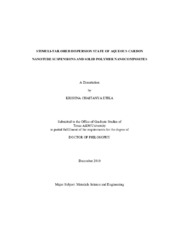| dc.description.abstract | Nanoparticles (such as, carbon nanotubes, carbon black, clay etc.) have one or
more dimensions of the order of 100 nm or less. Owing to very high van der Waals force
of attraction, these nanoparticles exist in a highly aggregated state. It is often required to
break these aggregates to truly experience the “nanosize” effect for any required end use.
There are several strategies proposed for dispersing/exfoliating nanoparticles but limited
progress has been made towards controlling their dispersion state. The ability to tailor
nanoparticle dispersion state in liquid and solid media can ultimately provide a powerful
method for tailoring the properties of solution processed nanoparticle-filled polymer
composites.
This dissertation reports the use of a variety of stimuli-responsive polymers to
control the dispersion state of single-walled carbon nanotubes. Stimuli-responsive
polymers exhibit conformational transitions as a function of applied stimulus (like pH,
temp, chemical etc.). These variations in conformations of the polymer can be used tailor
nanotube dispersion state in water and solid composites.The use of pH and temperature responsive polymers to stabilize/disperse single walled carbon nanotubes (SWNTs) in
water is presented. Non-covalent functionalization of SWNTs using pH and temperature
responsive polymer show tailored dispersion state as a function of pH and temperature,
respectively. Carbon nanotube microstructure in these aqueous suspensions was
characterized using several techniques (cryo-TEM, viscosity measurements, uv-vis
spectroscopy, zeta potential measurements and settling behavior). Furthermore, nanotube
dispersion state in aqueous suspensions is preserved to a large extent in the composites
formed by drying these suspensions as evidenced by SEM images and electrical
conductivity measurements. Based on the results obtained a mechanism is proposed to
explain the tailored dispersion of SWNTs as a functions of applied external stimulus
(i.e., pH, temperature). Such stimuli-controlled dispersion of carbon nanotubes could
have a variety of applications in nanoelectronics, sensing, and drug and gene delivery
systems. Furthermore, this dissertation also contains a published study focused on
controlling the dispersion state of carbon black (CB) in epoxy composites using clay. | en |


